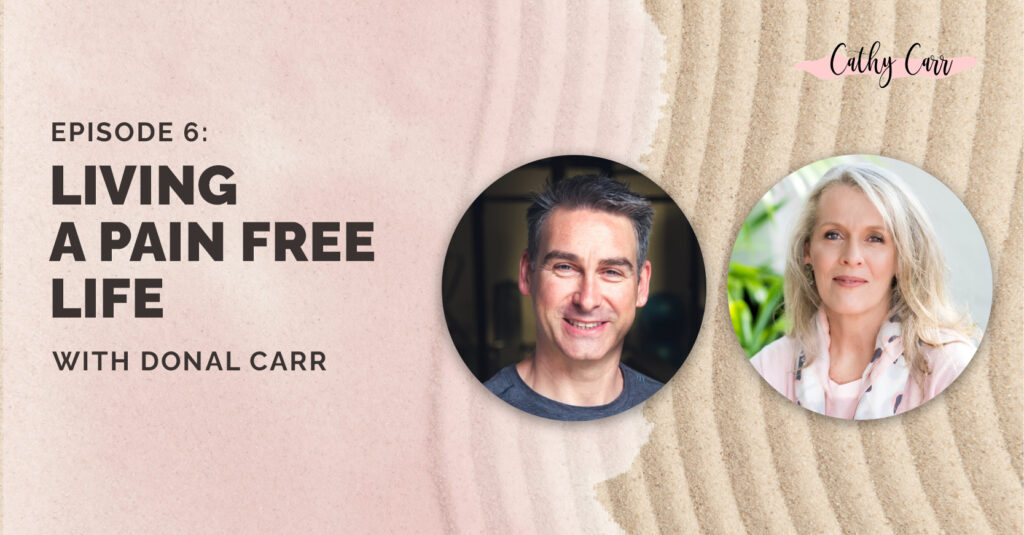One of the usual complaints of women in their 40s or older is pain. Discomfort can be felt in their backs, neck, hips, shoulders, and other parts of the body. Although medical experts can prescribe medicines that can relieve pain, a holistic approach leads you on the journey of living a pain-free life.
Our guest for the Rejuvenated Woman Podcast is none other than Donal Carr. She is Cathy’s husband who’s also an expert in Corrective Exercise, Rehabilitation & Sports performance. Donal has over 30 years of experience in the health and fitness industry. He is also a Senior CHEK Faculty Member & Level IV CHEK Practitioner.
Together, they discuss the usual symptoms of back pain, why women are prone to experience frozen shoulder at 40 and how to better understand an individual’s pain.
What are the usual symptoms of back pain?
Donal mentioned that according to the World Congress of Back Pain, “9 out of 10 people experience back pain at some stage in their lives.” He added that “females are six times more likely to experience pain at the SI joints or the foundation where the back sits.”
An online article by Mayo Clinic, states that the symptoms of back pain “range from muscle shooting, burning or a stabbing sensation.” This pain can travel all the way to the legs and may worsen with movements such as standing up, walking, bending, and twisting.
There are various tests that can be performed to figure out the causes of pain and the protocols that you need to adhere to are dependent on the results of these tests. Some of these tests are muscle testing, MRI, nerve blocks, and bone scans.
Donal expressed that “pain can radiate out or localized.” Individuals can either pinpoint where the pain is, we know that it’s not that severe yet. But when pain has traveled or diffused in various parts of the body and the pattern has been there for a while, it calls for the proper identification of pain and how long it’s been.
To properly identify the pain, we’ll need a multi-disciplinary approach that requires a lot of information from the individual. He/she needs to be aware of the usual time it comes on, and how to appropriately describe the pain (sharp stabbing sensations, swollen, burning, cramps) and other symptoms felt alongside pain.
Before you go and treat your pain symptoms, Donal’s advice is “to do your homework.” Make sure that you do your research and figure out the possible effects of one treatment.
Women in their 40s and Frozen Shoulders
Women in their 40s are more likely to have frozen shoulders hence the odd saying of “forty, fat, female, frozen shoulders.” This may not always be true but a lot of women in this age group tend to experience frozen shoulders. In fact, as per Mayo Clinic “people 40 years old or older, especially women are more likely to have frozen shoulder.”
Donal explains that this is due to the female body having less muscle mass and a different hormonal profile. By the time a woman reaches 40, testosterone levels slow down, she loses muscle mass and her structural support has been challenged. So if there’s no proper resistance training or weight and posture training, you will lose the tonic and posture muscles that are holding them in place.
He adds that the frozen shoulder has a direct link to the endocrine system. We know that the thyroid gland and shoulders are affected when the adrenals get burned out. Stressed and busy moms are likely to burn themselves out and the manifestation of this is the cortisol levels go up and the thyroid speeds up.
This leads the body to a stress-response state that affects all the other systems. And if the body stays in this state for a long time, it can’t rejuvenate itself. Now the body can’t use the nutrition it’s getting because it makes the organs its priorities.
Now we’ll see that the body builds a lot of tension in the neck and the upper parts get tight and restricted and this leads to frozen shoulders.
How to better understand an individual’s pain?
To better understand someone’s pain, Donal recommends looking at it with a holistic approach and fully investigating the individual. It’s not always about reacting to the root cause of the pain, there’s a need to examine above and below where the pain is.
Some basic things you may need to look at to discern the pain you’re feeling are:
- Are you dehydrated?
- How was your sleep last night?
- What have you done a day before the pain?
- Are you recovering from stress?
But if the pain has been lingering for a long time, and it’s getting worse, it’s important to seek medical attention. Be ready to explain and describe the kind of pain you’re experiencing and when you’d normally feel it.
Donal also recommends looking at every aspect of your life that might cause pain. Furthermore, analysing the pain chart of a client involves evaluating their nutritional diary and looking for correlations between pain and their habits. It’s also beneficial to find out stressors and know how they can be reduced or eliminated.
Conclusion
A rejuvenated woman has the ability to redesign, reshape and reenergize her body. She knows how to take control, and she makes sure that there is balance. It’s essential for her to maintain a healthy mind and body away from pain and discomforts.



